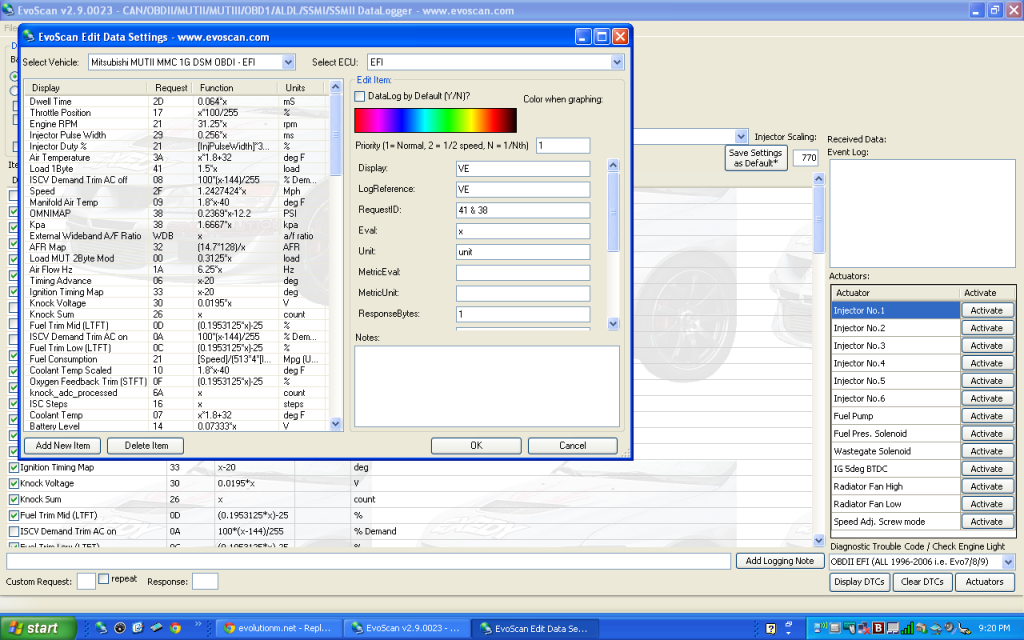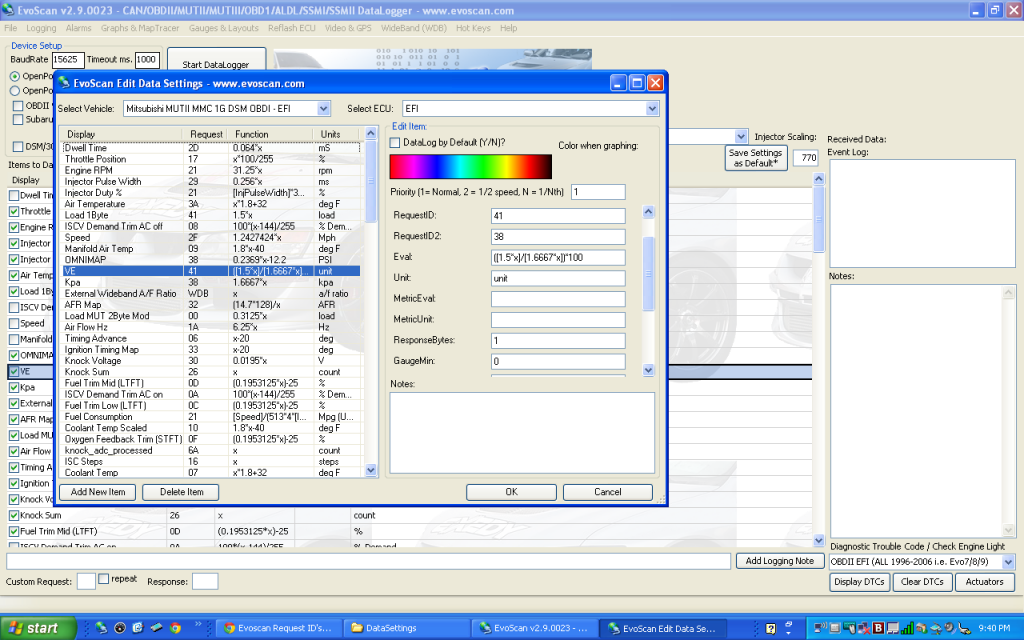Injector scaling vs actual afr in close loop? Also does ve change closed loop fueling
#31
I wonder if my injector are different size than I'm aware of
No amount of scaling or Latency makes any difference
Keeping tinkering though its gotta be fixable!
Might not be obvious with one parameter adjusted. Big changes get big results ve and maf this time !
No amount of scaling or Latency makes any difference

Keeping tinkering though its gotta be fixable!
Might not be obvious with one parameter adjusted. Big changes get big results ve and maf this time !
Last edited by 211Ratsbud; Dec 21, 2012 at 03:45 PM.
The following users liked this post:
Racing boost (Feb 14, 2023)
#32
Ok so after 25 mins if idling aka a nice hot shower and put the baby swing together I get -1.6 for my low trim and a stft right hovering at zero. Ended up taking fuel via maf comp and massive amounts of ve out. Afr display is still lean but I will be taking a closer look at the way things are down there soon
Should stft and ltft be the only thing I'm concerned about in cl?
Should stft and ltft be the only thing I'm concerned about in cl?
Last edited by 211Ratsbud; Dec 21, 2012 at 05:34 PM.
#34
Didn't check but my hz dropped to 31.25 from 37.5. I have a lot of ve work to do. I wish I could turn off ltft so I can log a light throttle accel and adjust maf/ve. Do you normally just do it free revving? How particular do I have to be?
Last edited by 211Ratsbud; Dec 22, 2012 at 08:31 PM.
#35
Low mid is -2 and 4 but I see stft jumping to 10ish at various spots after trims have settled ..so I know I took too much ve out at some spots
Last edited by 211Ratsbud; Dec 22, 2012 at 08:55 PM.
#38
If you tune the car first with a MAF (like everyone is supposed to, but doesn't) you can build an entire 3D VE Table in one long drive without lifting a finger, just driving. Its only time consuming if you choose to not use your MAF to do the work for you. You just need to log map sensor KPA along with your MAF readings. You will need a version of Evoscan with Live Map Tracer as well.
The only thing I have noticed that will make the conversion inaccurate is a poor MAF intake setup with turbulence.
-Jamie
The only thing I have noticed that will make the conversion inaccurate is a poor MAF intake setup with turbulence.
-Jamie
My MAF is de honey combed however
 It was damaged and I thought it was the reason when I was having a hard time tuning maf. This bit of SD learning has taught me a lot of how MAF tuning works, with out even using a MAF lol.
It was damaged and I thought it was the reason when I was having a hard time tuning maf. This bit of SD learning has taught me a lot of how MAF tuning works, with out even using a MAF lol.and... my BPV is recirculated but dumps into my exhaust mani, what kind of Data is needed?
Last edited by 211Ratsbud; Dec 23, 2012 at 07:13 AM.
#39
I would buy another or borrow one for a day.
Here is a simple way of explaining VE (there is more to it than this really). 100% VE means, at 100kpa with 100%VE, the engine assumes that 100KPA=100load. This means that the cylinders COMPLETELY suck in & push out their total volume of air and the ECU sends enough fuel to match. Due to turbulance and poor airflow at certain RPM and engine loads, 100% VE isn't always the case.
Lets use idle as an example. Most cars will idle at 40-65kpa. Lets use a stock Evo that pulls around -18 to -19inHG at idle (around 40KPA) and the maf reading shows a load of 30.
VE can be calculated by using this formula:
LOAD/KPA*100
30/40*100= 75% VE
This means at that particular KPA and RPM the cylinders are only sucking in/pushing out roughly 75% of their capacity and the ECU should only give 75% of the fuel to match.
Now lets use a big cam that has less vacuum. With the MAF installed, you may see -12inHG of vacuum at idle (about 60kpa) and a MAF calculated load of 33.
LOAD/KPA*100=VE
30/60*100= 50% VE
You can log VE in evoscan by using a formula similar to the one below while using your MAF:
([load1B]/[JDMMAPkpa])*100
After logging, you can use your averages in each KPA/RPM area to determine the MAF calculated VE. The more data you get for each cell, the more accurate your VE table will be.
Most evos I have seen have a VE of roughly 80% in the 2000-3000rpm/40-80KPA range for average highway cruising.
-Jamie
Here is a simple way of explaining VE (there is more to it than this really). 100% VE means, at 100kpa with 100%VE, the engine assumes that 100KPA=100load. This means that the cylinders COMPLETELY suck in & push out their total volume of air and the ECU sends enough fuel to match. Due to turbulance and poor airflow at certain RPM and engine loads, 100% VE isn't always the case.
Lets use idle as an example. Most cars will idle at 40-65kpa. Lets use a stock Evo that pulls around -18 to -19inHG at idle (around 40KPA) and the maf reading shows a load of 30.
VE can be calculated by using this formula:
LOAD/KPA*100
30/40*100= 75% VE
This means at that particular KPA and RPM the cylinders are only sucking in/pushing out roughly 75% of their capacity and the ECU should only give 75% of the fuel to match.
Now lets use a big cam that has less vacuum. With the MAF installed, you may see -12inHG of vacuum at idle (about 60kpa) and a MAF calculated load of 33.
LOAD/KPA*100=VE
30/60*100= 50% VE
You can log VE in evoscan by using a formula similar to the one below while using your MAF:
([load1B]/[JDMMAPkpa])*100
After logging, you can use your averages in each KPA/RPM area to determine the MAF calculated VE. The more data you get for each cell, the more accurate your VE table will be.
Most evos I have seen have a VE of roughly 80% in the 2000-3000rpm/40-80KPA range for average highway cruising.
-Jamie
Last edited by Dynotech Tuning; Dec 23, 2012 at 08:10 AM.
#43
How do I do this in EvoScan? Here is a screen shot. I started to do the 2 requests, but I've never seen that before. Do I just name it similar to how you have it?






